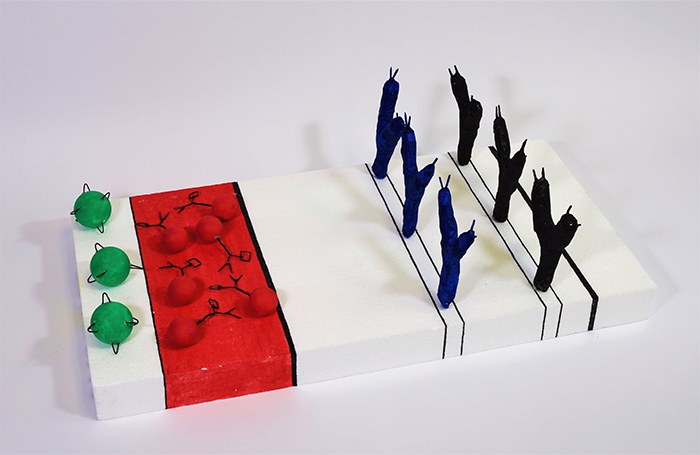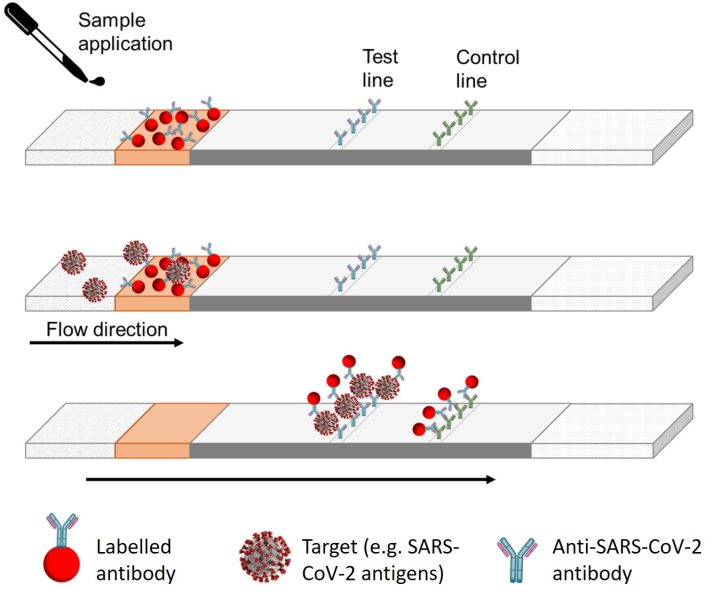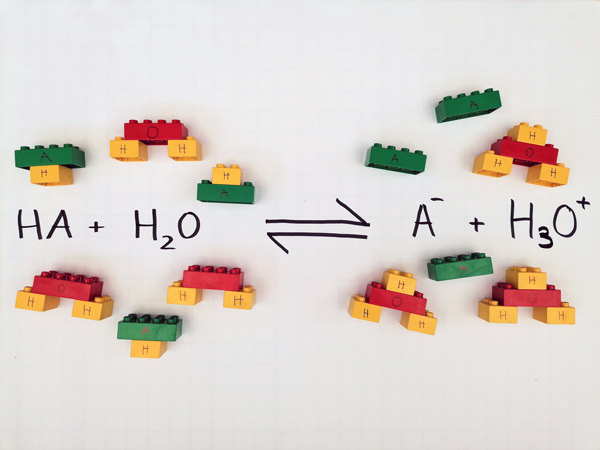Supporting materials
Test model building instructions
Test model demonstration sheet
Activity 3 - Student instruction
Extension activity – buffer model
Download
Download this article as a PDF

Fighting fake facts: When a Covid test shows a positive result with cola, does testing make sense? To answer this, one must understand how antigen tests and buffers work.
A major challenge of science teaching must be to raise awareness of the importance of critical thinking. Therefore, the difference between scientific-approved facts and subjective claims, which are biased and a matter of personal belief, should be made explicit. With these activities, students can broaden their skills of thinking critically. A further discussion about the necessity and ways to check so-called facts in general can follow. Additionally, curricular content like the function of buffers, pH levels, the structures of proteins, and the function of antibodies can be approached. This work was tested with pupils aged 16 in a science lab course offered by the university for schools. It may be used for students aged 14–19 with small alterations. To reduce costs for the COVID-19 test kits, it is recommended for students to work in groups for the activities requiring an antigen-based rapid diagnostic test (Ag-RDT).
In December 2020, a member of the Austrian right-wing party Freiheitliche Partei Österreichs (FPÖ) used his speech time in parliament to demonstrate that a COVID-19 Ag-RDT showed an allegedly positive result with a cola drink. He used this false-positive test to deny the efficacy of coronavirus testing in general. We can use the YouTube video of the speech[1] as an authentic and relevant anchoring phenomenon to teach the chemical principle of buffers.
This activity can be done in about 15 mins although more time might be needed for the discussion.
Note: When developing this unit, we found that not all tests showed a false-positive result, possibly because some have the buffer already in the sample pad. It is thus important to try different tests before the lesson and choose one that does give a false-positive result. If you can’t find any COVID antigen tests that show this effect, other antigen tests like some pregnancy tests may also work, although care must be taken in suggesting to students that they can ‘cheat’ some tests in this way. If no suitable tests can be found, the first two activities can still be run using the video and model, but it is much more engaging if students can test for themselves.
If students have prior knowledge about the function of Ag-RDTs, they may speculate that cola drinks could change the antigens or antibodies, or that some content of the soft drink could react with the gold complexes. To be able to reflect critically, firstly, the functioning of an antigen test must be understood, and secondly, that of buffers.
While the test from Activity 1 is running, the function of Ag-RDTs is explained. The activity takes about 10 mins.

The Ag-RDTs follow the lateral-flow method and are based on the principle of immune complexes, where an antigen and its specific antibody build an antigen–antibody complex.[4] The method can be used to detect COVID-19, to diagnose a pregnancy, or to predict the time of ovulation. Furthermore, these tests can also be used in nonmedical fields, for example, food and beverage manufacturing or environmental remediation.[5] In the following, the principle of an Ag-RDT is described by using the example of a COVID-19 Ag-RDT.

To test the hypothesis of the missing buffer, students repeat the COVID-19 Ag-RDT with a new kit, again testing with cola, but this time adding the buffer, according to the manufacturer’s instructions. While the test is running, students explore the question of what a buffer does by conducting an experiment. They use pH paper to compare the pH of the cola drink and the buffer solution.
This activity takes approximately 15 min.
The function of buffers can be nicely explained using building bricks; see Extension activity – buffer model in the supporting material.

Students should realise that the cola is acidic and that a buffer solution can stabilize the pH at a certain level.[6]
Once they compare the results of the COVID-19 Ag-RDT without (Activity 2) and with buffer solution (Activity 3), they should realize the importance of conducting a diagnostic rapid test according to the manufacturer’s instructions. Analogies can be drawn to using a cake mix and adding cola instead of eggs: you can’t expect things to work as advertised if you don’t follow the instructions!
Depending on the students’ prior knowledge of proteins, the effect of the acidic pH of cola drinks on the structure of proteins may be discussed, or even demonstrated by mixing the cola drink with (lukewarm) milk.
Students may also test further hypotheses, for example, that the acidity plays a role. Since the exact mechanism of each Ag-RDT varies, and proteins may be influenced by many factors, due to the weak interactions that determine protein folding, it is important to draw careful conclusions and take all possibilities into consideration.
To make a concluding statement, the students should review all previous activities. They combine their newfound knowledge to evaluate and judge the claim of the Austrian politician, which is obviously wrong. Because of the missing buffer solution during his execution, the ideal conditions (pH level) of the immunological reaction cannot be attained. It is possible that the acidic character of cola and some other drinks denatures the proteins in the tests, causing a false-positive outcome;[7] however, the exact mechanism has not been clarified. The work should be concluded by giving students the summary handout with the take-away points. The difference between beliefs or assumptions and scientifically tested and reproduceable results should be discussed. Teachers can link this what students have learned about the scientific method (e.g., dependent, independent, and control variables) and discuss how considering all the factors that affect the experimental system is important for evaluating whether the results really support the conclusion.
[1] Windschitl M, Thompson J, Braaten M (2018) Ambitious Science Teaching. Harvard Education Press. ISBN: 978-1-68253-163-1
[2] YouTube video of the politician’s talk (the relevant part is the first 1 min 40 s): https://www.youtube.com/watch?v=0-aGdBh_sXI
[3] Information about lateral flow assays from Lateral Flows, a part of Radetec Diagnostics: https://www.lateralflows.com/lateral-flow-assays/
[4] Luppa PB, Schlebusch H (2012) POCT – Patientennahe Labordiagnostik. Springer, Berlin, Heidelberg. ISBN: 978-3-642-20172-1
[5] Modrow S et al. (2010) Molekulare Virologie. Spektrum Akademischer Verlag, Heidelberg. ISBN: 978-3-8274-2241-5
[6] Velavan TP, Pallerla SR, Kremsner PG (2021) How to (ab)use COVID-19 antigen rapid test with soft drinks? International Journal of Infectious Diseases 111: 28–30. doi: 10.1016/j.ijid.2021.08.023
[7] Patriquin G et al. (2022) Generation of false-positive SARS-CoV-2 antigen results with testing conditions outside manufacturer recommendations: a scientific approach to pandemic misinformation Microbiology Spectrum 9: e0068321. doi: 10.1128/Spectrum.00683-21
The topic covered in this article is very interesting and current for creating activities that educate upper secondary school students in critical thinking. The discussion is developed in a theoretical and innovative experimental way with an interdisciplinary approach linking the biology of the immune system and the chemistry of acids and bases, also proposing engaging practical learning by doing activities. Particularly useful for working with students is the explanation of the antigen rapid test, the principle in immunological reactions, and the Lego model for explaining buffers. The didactic proposal can be developed at two levels: at a basic level for students aged 14-16, and at a higher level for students aged 17-18, with specific insights into the immune system and the chemistry of buffers and acid–base theories to guide classes through reasoned interpretation of the results of a diagnostic test. The article is also more broadly useful for educating students on interpreting scientific information without bias.
Marina Minoli, Bioscience didactic researcher and professor